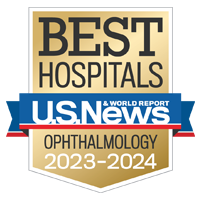Cataracts

Overview
Cataracts are the most common cause of vision loss, especially for people over age 60. The condition causes your eye lens to become cloudy, which makes your vision blurry or dim. Developing cataracts is a normal part of aging. By age 80, more than half of all Americans either have a cataract or have had cataract surgery – the only treatment for the condition. Eye drops, exercise or glasses will not make the cataract disappear once it has formed.
In addition to aging, cataracts may be caused by other eye diseases or previous eye surgery; certain chronic conditions such as diabetes; excessive use of certain medications, such as steroids; or eye injury. Cataracts may also occur in children or infants and can be removed safely, restoring good vision.
Our approach to cataracts
UCSF is home to the largest eye surgery program in Northern California, and our ophthalmologists are experts in the surgical removal of cataracts to restore vision. While removing cataracts, they can also perform advanced procedures to correct other vision issues, such as farsightedness, nearsightedness and astigmatism.
Awards & recognition
-

Among the top hospitals in the nation
-

Best in Northern California and No. 9 in the nation for ophthalmology
Signs & symptoms
Cataracts progress slowly; in the early stages of the disease, you may not notice any major changes in your vision. Glasses or contact lenses can help correct these minor visual problems. But as the condition progresses, your vision may become seriously impaired and surgery may be required.
Symptoms include:
- Painless cloudy, blurry or dim vision
- More difficulty seeing at night or in low light
- Sensitivity to light and glare
- Seeing halos around lights
- Faded or yellowed colors
- The need for brighter light for reading and other activities
- Frequent changes in eyeglass or contact lens prescription
- Double vision within one eye
Diagnosis
To make a diagnosis of cataracts, you will first have a dilated eye exam, in which drops are placed into your eye to make your pupil dilate, or widen. Your ophthalmologist will then use a special magnifying lens to examine your retina and optic nerve for any signs of damage. After the exam, your close-up vision may be blurred for several hours.
Other tests include:
- Refraction Test
- Slit-lamp Exam. A slit-lamp is a special type of microscope that allows your ophthalmologist to examine your eye's cornea, iris and lens in small, detailed sections.
- Retinal Exam. Using a slit-lamp or special instrument called an ophthalmoscope, your ophthalmologist will look through your pupil at the vitreous, retina and other structures located inside the back portion of your eye for signs of cataracts or other eye diseases.
Treatments
Glasses or contact lenses may correct minor vision problems caused by early stage cataracts. As the disease progresses, however, surgery — the only treatment for cataracts — may be necessary. Eye drops, exercise or glasses will not make the cataract disappear once it has formed.
Cataract surgery is usually an outpatient procedure and does not require an overnight stay in the hospital.
Phacoemulsification
Phacoemulsification is a very common method for cataract surgery which uses ultrasound to help remove the cataract. During phacoemulsification, the cataract is removed and replaced with an artificial lens made of plastic, silicone or acrylic called an intraocular lens (IOL). The IOL becomes a permanent part of your eye and allows light to pass through and focus properly on the retina. Before it is inserted, your ophthalmologist will make a small incision in the side of your cornea. A tiny instrument that uses high-frequency ultrasound will be used to break up the cataract and suction it out. The IOL is then inserted and once in place, your surgeon will close the incision. Afterwards, a protective shield will be placed over your eye.
Refractive lens exchange
Refractive lens exchange (RLE) is similar to cataract surgery, but can be used for patients who do not have advanced cataracts. During the procedure, the ageing natural lens of the eye is replaced with a new intra-ocular lens that corrects nearsightedness and farsightedness, as well as vision problems caused by cataracts.
RLE is the treatment of choice for people over 50 or for those who have mild cataracts, as well as other vision problems that are too severe to be treated effectively or safely by laser eye surgery, such as LASIK.
UCSF Health medical specialists have reviewed this information. It is for educational purposes only and is not intended to replace the advice of your doctor or other health care provider. We encourage you to discuss any questions or concerns you may have with your provider.









